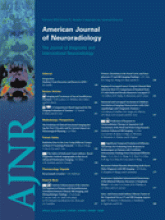Abstract
BACKGROUND AND PURPOSE: Temporal bone CT is performed frequently in clinical practice. At the same time, the eye lens are exposed to ionizing radiation without any useful diagnostic information delivered. Our aim was to investigate the radiation dose to the lens of the eye by using temporal bone CT scanning with different protocols.
MATERIALS AND METHODS: Direct axial and coronal CT by using a conventional sequential scanning mode (140 kV, 220 mAs/section, 1.25-mm thickness, 1.25-mm increment, 16 × 0.625 mm collimation, the glabellomeatal line as a scanning baseline), a routine helical scanning mode (140 kV, 220 mAs/section, 0.315 pitch, 0.67-mm thickness, 0.33-mm increment, 16 × 0.625 collimation, the orbitomeatal line as a scanning baseline), and a modified helical scanning mode (acanthiomeatal line as a scanning baseline; other parameters, same as above) was performed on an exsomatized cadaveric head. CTDIvol and DLP were recorded for each scanning mode, and effective doses were calculated. Organ doses for the lens were measured with TLDs.
RESULTS: When the sequential scanning mode was used, the gross effective dose was 1.21 mSv and the organ dose to the lens was 50.96 and 1.73 mGy, respectively, for direct axial and coronal imaging. The effective dose was 0.803 mSv in routine helical scanning, while the lens dose was 40.17 mGy. With the modified helical scanning mode, the effective dose was as same as that for the routine helical scanning, but the lens dose was reduced significantly to 10.33 mGy.
CONCLUSIONS: The effective doses resulting from sequential axial and coronal scanning were 1.51 times higher than the dose from helical scanning, and the lens dose was 1.31 times higher. With the modified helical scanning mode, thinner section images could be used to reformat axial, coronal, and sagittal images with a further 74.3% reduction in lens dose beyond that achieved with the conventional helical protocol.
Abbreviations
- CTDIvol
- volume CT dose index
- DLP
- dose-length product
- MSCT
- multisection CT
- TLD
- thermoluminescence dosimeter.
- Copyright © American Society of Neuroradiology












